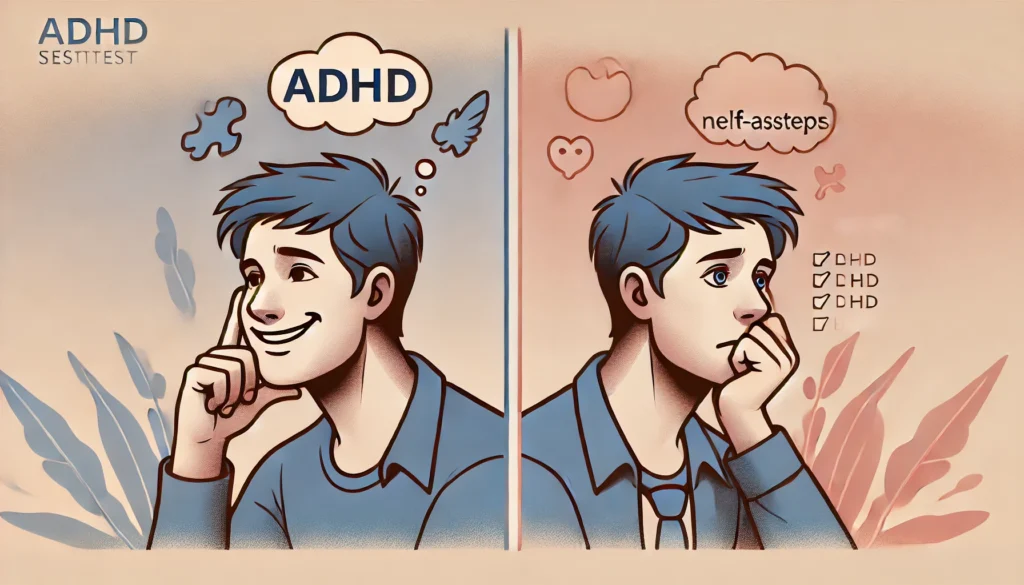Fortunately, numerous free online ADHD tests can provide valuable insights into whether further professional evaluation is warranted. In this article, we will explore some of the top free ADHD tests, their features, and how they can serve as a starting point in your journey to understanding ADHD.
You may also like: Enhancing Concentration: Strategies for ADHD
Understanding ADHD: A Brief Overview
Before delving into the tests, it’s vital to comprehend what ADHD entails. The disorder is categorized into three main types: predominantly inattentive presentation, predominantly hyperactive-impulsive presentation, and combined presentation. Each type reflects a different cluster of symptoms and can significantly impact an individual’s daily life.
The Three Types of ADHD
The predominantly inattentive presentation is characterized by symptoms such as forgetfulness, disorganization, and difficulty sustaining attention. This type is often harder to identify, especially in children, because it doesn’t involve the disruptive behaviors typically associated with hyperactivity. In contrast, the predominantly hyperactive-impulsive presentation includes symptoms like fidgeting, interrupting others, and an inability to remain still. This type is more noticeable and often diagnosed earlier in children. The combined presentation involves a mix of inattentive and hyperactive-impulsive symptoms, making it the most common form of ADHD.
Historical Evolution of ADHD Understanding
Historically, ADHD was first recognized in the early 20th century, but our understanding has evolved significantly over the decades. Initially described as a hyperkinetic impulse disorder, it was often misunderstood and misdiagnosed. As research progressed, particularly in the latter half of the 20th century, ADHD began to be recognized as a legitimate neurodevelopmental disorder. Today, ADHD is recognized not just in children, but also in adults who may have had symptoms go unnoticed during their youth. This shift acknowledges that ADHD is a lifelong condition that requires understanding and management across all ages.
ADHD in Adults: A Growing Recognition
ADHD in adults is increasingly recognized as awareness of the disorder grows. Many adults who were not diagnosed in childhood continue to struggle with its symptoms, impacting their professional and personal lives. Adult ADHD can manifest in challenges with time management, organizational skills, and maintaining focus on tasks. Recognizing these symptoms is crucial for adults seeking to improve their quality of life through appropriate interventions.
The Importance of Early Identification
Identifying ADHD early can lead to better management and improved quality of life. Untreated ADHD can lead to challenges in academic, professional, and social settings. Thus, understanding the symptoms and seeking appropriate help is crucial.

Top Free ADHD Tests
1. ADHD Self-Report Scale (ASRS)
Developed in conjunction with the World Health Organization, the ADHD Self-Report Scale (ASRS) is a widely used tool for identifying symptoms of ADHD in adults. This test consists of 18 questions designed to evaluate the frequency of ADHD symptoms. It’s a quick and effective way to gauge whether professional consultation might be necessary.
How the ASRS Works
The ASRS is structured to assess how frequently an individual experiences symptoms that are commonly associated with ADHD. Questions are framed to reflect everyday scenarios, making it relatable and easy to answer. Each question is rated on a scale, with higher scores indicating a greater likelihood of ADHD. This straightforward approach helps individuals quickly ascertain the necessity of pursuing further evaluation.
Benefits of Using the ASRS
One of the key benefits of the ASRS is its accessibility and ease of use. It requires no special preparation and can be completed in a short time. The results provide a snapshot of one’s symptoms, which can be invaluable in deciding whether to seek further professional advice. This test is particularly beneficial for adults who suspect they have undiagnosed ADHD, as it offers a preliminary assessment that can encourage them to seek a full diagnosis.
Limitations of the ASRS
While the ASRS is a useful screening tool, it is not a substitute for a professional diagnosis. It is designed to highlight potential areas of concern rather than provide a definitive diagnosis. Individuals should use the results as a guide to discuss symptoms with a healthcare provider who can conduct a more comprehensive evaluation.
2. Conners’ Adult ADHD Rating Scales (CAARS)
The Conners’ Adult ADHD Rating Scales provide a comprehensive assessment of ADHD symptoms. Although the full CAARS is a paid resource, many online platforms offer abbreviated versions for free. These can help identify potential ADHD symptoms and are particularly useful for adults who suspect they may have been living with undiagnosed ADHD.
Overview of CAARS
CAARS is a detailed tool that evaluates a wide range of ADHD symptoms in adults. It covers aspects such as attention difficulties, hyperactivity, impulsivity, and emotional symptoms. The free versions available online offer a condensed assessment that still provides valuable insights into one’s symptomatology.
The Utility of CAARS for Self-Assessment
For those unsure about whether their symptoms align with ADHD, CAARS offers a structured approach to self-assessment. By answering the questions honestly, individuals can gain a clearer understanding of their symptoms and how they may impact daily life. This clarity can be the first step towards seeking a formal evaluation and, if necessary, starting a treatment plan.
Interpreting CAARS Results
After completing a CAARS assessment, individuals receive a score that indicates the presence and severity of ADHD symptoms. While this score is informative, it is crucial to follow up with a healthcare provider for a comprehensive diagnosis. The CAARS is a helpful tool in the initial stages but should be complemented by professional guidance for accurate interpretation and next steps.
3. Jasper/Goldberg Adult ADD Questionnaire
This self-assessment tool, named after its creators Ivan Goldberg and Jasper, includes a series of questions that cover a broad range of ADHD symptoms. It’s designed to provide an overview of how ADHD symptoms may be affecting your life and whether you should pursue a formal diagnosis.
Structure of the Jasper/Goldberg Questionnaire
The questionnaire is composed of various statements related to common ADHD symptoms, and respondents are asked to rate the frequency or severity of these experiences. This format allows individuals to reflect on their symptoms in a structured manner. The questions are crafted to address both attention deficits and hyperactive-impulsive behaviors, offering a comprehensive overview of the individual’s symptom profile.
Who Can Benefit from the Jasper/Goldberg Questionnaire?
This tool is beneficial for adults who suspect they might have ADHD but have never been formally assessed. It provides a preliminary indication of whether further investigation is warranted. By identifying patterns in responses, users can gain insights into how ADHD might be influencing their daily functioning, prompting them to seek professional evaluation.
Limitations and Considerations
Like other self-assessment tools, the Jasper/Goldberg Questionnaire is not a substitute for a professional diagnosis. It is intended to guide individuals towards understanding their symptoms better and motivating them to seek formal evaluation. The results should be viewed as a starting point for discussion with a healthcare professional who can provide a detailed assessment.
4. Amen Clinics ADHD Type Test
The Amen Clinics offer a free online test that identifies which of the seven types of ADHD you may have. This test is based on the work of Dr. Daniel Amen, who categorized ADHD into seven types, each with distinct characteristics and treatment approaches.
The Seven Types of ADHD
Dr. Amen’s classification expands on the traditional understanding of ADHD by introducing subtypes such as Classic, Inattentive, Overfocused, Temporal Lobe, Limbic, Ring of Fire, and Anxious ADHD. Each type has specific symptoms and requires tailored management strategies. Understanding which type you might have can help in developing a targeted treatment plan.
How the Amen Clinics Test Works
The test involves a series of questions designed to evaluate the presence of symptoms across the seven ADHD types. By analyzing responses, the test provides insights into which subtype may be most prevalent in the individual. This nuanced approach allows for a more personalized understanding of ADHD, which can be crucial for effective management.
Using the Results to Inform Treatment
The results of the Amen Clinics test can guide individuals in seeking appropriate interventions. Knowing the specific type of ADHD can help in choosing the right therapeutic approaches, whether they involve medication, behavioral therapy, or lifestyle changes. As with all self-assessment tools, it is important to discuss the results with a healthcare professional to ensure a comprehensive treatment plan.
5. Psych Central’s ADHD/ADD Quiz
Psych Central provides a straightforward quiz that helps you assess the likelihood of having ADHD. It’s a great starting point for those who want a quick overview of their symptoms and whether they align with ADHD.
The Simplicity of Psych Central’s Quiz
The quiz is designed to be quick and easy, making it accessible to a wide audience. It consists of questions that cover key ADHD symptoms, allowing individuals to rapidly gauge whether their experiences align with the disorder. The straightforward nature of the quiz makes it an ideal first step for those beginning their exploration of ADHD.
Who Should Consider Taking This Quiz?
Anyone who has noticed persistent symptoms of inattention or hyperactivity can benefit from taking this quiz. It is particularly useful for individuals who are new to the concept of ADHD and want a basic understanding before seeking further assessment. The quiz provides an initial indication of whether ADHD might be a concern, prompting users to consider professional evaluation.
Next Steps After the Quiz
Upon completing the quiz, individuals receive a score that suggests the likelihood of ADHD. While the results are informative, they are not definitive and should be followed up with a professional consultation. A healthcare provider can offer a detailed assessment and discuss potential strategies for managing symptoms effectively.
6. ADDitude’s ADHD Symptom Test for Adults
ADDitude, a magazine focused on ADHD, offers a symptom test that is both comprehensive and easy to navigate. This test helps in identifying the symptoms of ADHD and provides a detailed report that can be useful during professional evaluations.
Features of ADDitude’s Symptom Test
The test is designed to cover a broad spectrum of ADHD symptoms, providing a thorough overview of one’s experiences. It includes questions that address both inattentive and hyperactive-impulsive behaviors, ensuring a comprehensive assessment. The resulting report is detailed, offering insights that can be instrumental during a professional consultation.
The Value of a Comprehensive Report
The report generated by the ADDitude test provides a structured overview of symptoms, which can be valuable during discussions with healthcare providers. This documentation can help professionals understand the individual’s experiences better and develop a tailored treatment plan. The test is especially beneficial for those preparing for an initial evaluation, as it organizes information in a clear and concise manner.
Preparing for Professional Evaluation
After completing the ADDitude test, individuals are encouraged to share the report with their healthcare provider. This preparation can facilitate a more efficient evaluation process, allowing the professional to focus on key areas of concern. It also empowers individuals to take an active role in their healthcare journey by providing them with a detailed understanding of their symptoms.
7. Understood’s ADHD Test for Adolescents
Understood.org offers a test specifically designed for teenagers. This can be an invaluable resource for parents who suspect their adolescent might be experiencing ADHD symptoms and want to initiate a conversation about it.
Tailored for Adolescents
The test is crafted to address the unique challenges faced by teenagers with ADHD. It includes questions that reflect common adolescent experiences, such as difficulties in school, social interactions, and managing responsibilities. This tailored approach ensures that the test resonates with the experiences of teenagers, making it a useful tool for parents and educators.
Engaging Parents and Educators
Parents and educators play a crucial role in recognizing and addressing ADHD symptoms in adolescents. The Understood test provides a platform for initiating conversations about ADHD, helping caregivers understand the challenges faced by teenagers. By using the test results as a starting point, parents can engage in meaningful discussions with their children and seek professional guidance if needed.
Supporting Adolescents with ADHD
Understanding ADHD symptoms in adolescents is the first step towards providing effective support. The test results can guide parents and educators in developing strategies to help teenagers manage their symptoms, whether through academic accommodations, behavioral interventions, or professional therapy. Early identification and intervention are key to helping adolescents navigate the challenges of ADHD successfully.

Interpreting ADHD Test Results
While these tests can provide a useful starting point, they are not diagnostic tools. They are designed to highlight potential symptoms and encourage further exploration with a healthcare professional. A formal diagnosis requires a comprehensive evaluation by a psychiatrist, psychologist, or other qualified mental health professional.
What to Do After Taking an ADHD Test
If your results suggest that ADHD might be a concern, consider scheduling an appointment with a healthcare provider. They can offer a thorough assessment and discuss potential treatment options, which may include behavioral therapy, medication, or lifestyle changes.
Seeking Professional Consultation
The first step after a positive test result is to consult with a healthcare provider who specializes in ADHD. This professional can conduct a detailed evaluation, considering factors such as medical history, current symptoms, and any co-occurring conditions. A comprehensive assessment is essential for developing an effective treatment plan that addresses the individual’s unique needs.
Exploring Treatment Options
Once a diagnosis is confirmed, the healthcare provider will discuss various treatment options. These may include behavioral therapies, which focus on developing coping strategies and improving organizational skills. Medication may also be recommended to manage symptoms, alongside lifestyle changes such as regular exercise and a balanced diet. The goal is to create a holistic approach that supports the individual’s overall well-being.
The Importance of Follow-Up
Regular follow-ups with a healthcare provider are crucial for monitoring progress and adjusting treatment plans as needed. ADHD management is an ongoing process, and adjustments may be necessary to ensure optimal outcomes. By maintaining open communication with their healthcare team, individuals can effectively manage their symptoms and improve their quality of life.
The Role of Professional Evaluation
Professional evaluation is critical, as ADHD symptoms can overlap with other conditions such as anxiety, depression, or learning disabilities. A healthcare provider will be able to differentiate between these possibilities and provide a tailored treatment plan.
Differentiating ADHD from Other Conditions
ADHD symptoms can be similar to those of other mental health conditions, making accurate diagnosis challenging. A professional evaluation involves a thorough assessment to distinguish ADHD from conditions like anxiety, depression, or learning disabilities. This differentiation is crucial for developing an effective treatment plan that addresses the correct condition.
Comprehensive Diagnostic Process
A comprehensive diagnostic process typically involves interviews, questionnaires, and sometimes neuropsychological testing. The healthcare provider will gather information from multiple sources, including the individual, family members, and educators, to gain a complete understanding of the symptoms. This holistic approach ensures that the diagnosis is accurate and that the treatment plan is tailored to the individual’s specific needs.
Developing a Tailored Treatment Plan
Once the diagnosis is confirmed, the healthcare provider will work with the individual to develop a personalized treatment plan. This plan may include a combination of medication, therapy, and lifestyle modifications. By addressing the individual’s unique challenges and strengths, the treatment plan aims to improve daily functioning and enhance overall quality of life.

Conclusion: Taking the First Step
Understanding ADHD is the first step in managing its symptoms effectively. These free tests offer a valuable resource for anyone seeking to understand their symptoms better and take proactive steps towards getting help. Remember, while these tests are a starting point, professional guidance is essential for accurate diagnosis and treatment planning.
In your journey of understanding ADHD, staying informed and seeking professional help when needed can make all the difference. Whether you are a health and wellness coach, a science journalist, or a biohacker, having access to reliable information empowers you to make informed decisions and support others on their path to mental wellness.
Empowering Yourself and Others
By educating yourself about ADHD, you can better manage your symptoms and support those around you. Sharing accurate information and encouraging open discussions can help reduce stigma and promote understanding. As you navigate this journey, remember that seeking professional support is a sign of strength and a crucial step towards improved mental health.
Building a Support Network
Building a support network is vital for individuals with ADHD. Connecting with others who have similar experiences can provide valuable insights and encouragement. Support groups, both online and in-person, offer a platform for sharing experiences, coping strategies, and resources. A strong support network can significantly enhance the journey towards managing ADHD effectively.
The Ongoing Journey of ADHD Management
Managing ADHD is an ongoing journey that requires patience, persistence, and adaptability. As new research and treatments emerge, staying informed and open to change can help individuals optimize their management strategies. With the right resources and support, individuals with ADHD can lead fulfilling and productive lives.
In conclusion, these free ADHD tests serve as a starting point for understanding symptoms and seeking professional evaluation. By taking proactive steps and leveraging available resources, individuals can empower themselves to manage ADHD effectively and improve their quality of life.
Further Reading:
ADHD Test: Identifying Symptoms in Teens and Children
Important Note: The information contained in this article is for general informational purposes only, and should not be construed as health or medical advice, nor is it intended to diagnose, prevent, treat, or cure any disease or health condition. Before embarking on any diet, fitness regimen, or program of nutritional supplementation, it is advisable to consult your healthcare professional in order to determine its safety and probable efficacy in terms of your individual state of health.
Regarding Nutritional Supplements Or Other Non-Prescription Health Products: If any nutritional supplements or other non-prescription health products are mentioned in the foregoing article, any claims or statements made about them have not been evaluated by the U.S. Food and Drug Administration, and such nutritional supplements or other health products are not intended to diagnose, treat, cure, or prevent any disease.


